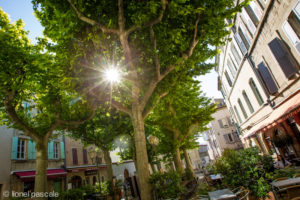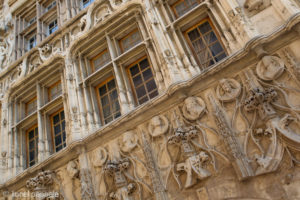A guided tour of downtown Valence is organised on Tuesday 30th May at 5:45 pm (until 7:30 pm).
The meeting point is right outside the tourist information centre:
Office de Tourisme et des Congrès, 11 boulevard Bancel Valence.
To join in, please book the tour in English or in French on the online questionnaire sent by e-mail.
Here is where the Midi begins !
 Valence, the strategic capital of the Drôme département, is the gateway to the South of France. Situated where the Vercors Mountains meet the Ardèche, on the banks of the mighty River Rhône, Valence and its surrounding area reflect a certain lifestyle, a way of life on a human scale.
Valence, the strategic capital of the Drôme département, is the gateway to the South of France. Situated where the Vercors Mountains meet the Ardèche, on the banks of the mighty River Rhône, Valence and its surrounding area reflect a certain lifestyle, a way of life on a human scale.
With a population of 70,000 inhabitants and a conurbation of 210,000 inhabitants, Valence has held on to all the charm and unspoilt character typical of the historical towns and cities of the South of France. Its colourful markets, parks and gardens, characterful shady terraces and welcoming pedestrianised streets have a distinctly Provençal feel about them. In ancient times a Roman city, Valence boasts a host of sights that prove a draw to visitors: a highly original historical and architectural heritage, awarded ‘Ville d’Art et d’Histoire’ certification in 1985; a rich and varied gastronomic reputation combining big names in French cuisine with mouthwatering culinary specialities; an active cultural and sporting scene which animates the whole area all year long.
Today, Valence is the beating heart of an urban community that draws on a wealth of riches from the surrounding countryside.
AN ARCHITECTURAL HERITAGE THAT REFLECTS A VIBRANT HISTORY
Valence’s fascinating history is laid out for all to see in the streets and historical centre, which is crammed with architectural treasures. The host of monuments in the heart of the pedestrianised district that survive to this day reflect the different eras and key chapters in the city’s development.
- The Kiosque Peynet: The best-loved of all the city’s monuments is still the Kiosque Peynet, a splendid bandstand built by Eugène Poitoux in 1890 and made world-famous by a romantic story. On a summer’s evening in 1942, the illustrator Raymond Peynet, who was staying in Valence at the time, drew a cartoon of two young lovers – a violinist and his sweetheart – which became known as ‘les amoureux de Peynet’. Standing in the middle of the city centre, overlooking Valence’s biggest park, the Kiosque Peynet has become a symbol of French romantic love.
 The Maison des Têtes: The Maison des Têtes was built in Valence in the early 16th century. The property of a university professor who was also consul of Valence, this building owes its name to the many carved heads decorating its façade, representing emblematic figures such as the Winds, Fortune, Law, Theology and Medicine. The way to the Renaissance-style internal courtyard is through a corridor lined with busts of Roman emperors.
The Maison des Têtes: The Maison des Têtes was built in Valence in the early 16th century. The property of a university professor who was also consul of Valence, this building owes its name to the many carved heads decorating its façade, representing emblematic figures such as the Winds, Fortune, Law, Theology and Medicine. The way to the Renaissance-style internal courtyard is through a corridor lined with busts of Roman emperors.- The Pendentif: One of the city’s first buildings to be listed as a historical monument, the Pendentif is so called because of its unusual architectural design: its arch contains a cupola on pendentives. Constructed in the cathedral cloister in 1548, this building has served a number of functions over the years. Initially built as a funerary monument, it is also thought to have once been a bar and even a cesspit before becoming part of the city’s historical heritage.
- The steep streets: Valence, a Roman city, was built on a series of levels, the ‘terraces’ that give the city its terraced appearance. All over the city, steep cobbled streets connect the different quarters, from the banks of the Rhône up to Valence-le-Haut.
- Cathédrale Saint Apollinaire: The cathedral, one of Valence’s most ancient monuments, was consecrated on 5 August 1095 by the Pope while he was on his way to preach the First Crusade. Since then the cathedral has undergone many transformations, particularly during its reconstruction in the early 17th century following the Wars of Religion. A staging post on the pilgrimage route, it has an ambulatory for accommodating travellers. In the middle of the cathedral stands a bust of Pope Pius VI, a historical figure who was taken prisoner in Valence during his flight from Rome, which had been taken over by the Directory. It contains his entrails and heart in commemoration of this episode from history.
- Eglise Saint Jean: On the corner of Place Saint-Jean with its distinctive market canopies is the Eglise Saint Jean. This quarter is one of the city’s oldest parishes. Rebuilt on several occasions, this monument has a number of features that make it worth the detour: a fine 19th century neo-Romanesque belfry which dominates the square, and above all the eight distinctive carved Romanesque capitals at its bottom.
CULTURAL DIVERSITY
The thriving Valence conurbation is a key centre of the region’s cultural and recreational life. A diverse cultural heritage has grown up in this culturally vibrant city.
> FOR MORE INFORMATION
The Château de Grignan was built in the Middle Ages as an acropolis dominating the site and the village. 16th century rebuilding transformed the edifice into one of the greatest Renaissance châteaux of South-East France and further building in the 17th century into « one of the finest antiquities in France ». The presence of Madame de Sevigné and her daughter Madame de Grignan, the privileged place the château occupies in their correspondence and the influence of Comte François de Castellane Adhémar de Monteil, « Viceroy » of Provence from 1669 to 1714, all conspire to make this a key site in the history of the region.
For a first view of the Château de Grignan
Tourist program in Drôme/Ardèche
For the pleasure of discovering Drôme
http://www.ladrometourisme.com/en/la-drome-tourisme-about-us.html
For the pleasure of discovering Ardèche








